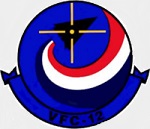Hobby Master HA3553 US Navy Boeing F/A-18+ Hornet Strike Fighter - 162841, VFC-12 "Fighting Omars", NAS Oceana, Virginia, 2018 [Aggressor Scheme] (1:72 Scale)
"Kill The Fleet"
- Motto of VFC-12 "Fighting Omars"
 The F/A-18 Hornet is the true multi-role aircraft. It can vault from a carrier deck, bomb a target and stay to dogfight even the best enemy aircraft without missing a beat. It's the Navy's first modern-era jet intended for double duty against air- and ground-based adversaries. Armed to the hilt with Sparrow and Sidewinder air-to-air missiles, an internal cannon, and laser-guided bombs, this modern warbird was an outstanding performer in Operation Desert Storm. Strapped into a digital cockpit described as a cross between Star Wars and a video game, pilots of the F/A-18 Hornet take on the ultimate aviation job: blasting this single-seat, high-performance jet off the deck of a carrier, dropping bombs, and firing air-to-ground ordnance. Offering unmatched agility, the Hornet is the choice aircraft of the US Navy's elite Blue Angels aerobatic team.
The F/A-18 Hornet is the true multi-role aircraft. It can vault from a carrier deck, bomb a target and stay to dogfight even the best enemy aircraft without missing a beat. It's the Navy's first modern-era jet intended for double duty against air- and ground-based adversaries. Armed to the hilt with Sparrow and Sidewinder air-to-air missiles, an internal cannon, and laser-guided bombs, this modern warbird was an outstanding performer in Operation Desert Storm. Strapped into a digital cockpit described as a cross between Star Wars and a video game, pilots of the F/A-18 Hornet take on the ultimate aviation job: blasting this single-seat, high-performance jet off the deck of a carrier, dropping bombs, and firing air-to-ground ordnance. Offering unmatched agility, the Hornet is the choice aircraft of the US Navy's elite Blue Angels aerobatic team.
The F/A-18C is the single-seat variant and the F/A-18D is the two-seat variant. The D-model can be configured for training or as an all-weather strike craft. The "missionized" D model's rear seat is configured for a Marine Corps Naval Flight Officer who functions as a Weapons and Sensors Officer to assist in operating the weapons systems. The F/A-18D is primarily operated by the U.S. Marine Corps in the night attack and Forward Air Controller (Airborne) (FAC(A)) roles.
The F/A-18C and D models are the result of a block upgrade in 1987 incorporating upgraded radar, avionics, and the capacity to carry new missiles such as the AIM-120 AMRAAM air-to-air missile and AGM-65 Maverick and AGM-84 Harpoon air-to-surface missiles. Other upgrades include the Martin-Baker NACES (Navy Aircrew Common ejection seat), and a self-protection jammer. A synthetic aperture ground mapping radar enables the pilot to locate targets in poor visibility conditions. C and D models delivered since 1989 also have improved night attack abilities, consisting of the Hughes AN/AAR-50 thermal navigation pod, the Loral AN/AAS-38 NITE Hawk FLIR (forward looking infrared array) targeting pod, night vision goggles, and two full-color (formerly monochrome) multi-function display (MFDs) and a color moving map.
Pictured here is a gorgeous 1:72 scale diecast replica of a US Navy Boeing F/A-18+ Hornet Strike Fighter that was attached to Fighter Squadron Composite Twelve (VFC-12) "Fighting Omars" then deployed to NAS Oceana, Virginia, during 2018.
Sold Out!
Dimensions:
Wingspan: 7-1/2-inches
Length: 9-inches
Release Date: December 2020
 Historical Account: "Fighting Omars" - Fighter Squadron Composite Twelve (VFC-12) is a United States Navy Reserve fighter squadron based at NAS Oceana, providing adversary training to East Coast air wings. VFC-12 reports to Commander Tactical Support Wing, a component of Commander, Naval Air Reserve Force (COMNAVAIRESFOR). The "Fighting Omars" is manned by selected reservists, full-time reservists (FTS) and active duty personnel.
Historical Account: "Fighting Omars" - Fighter Squadron Composite Twelve (VFC-12) is a United States Navy Reserve fighter squadron based at NAS Oceana, providing adversary training to East Coast air wings. VFC-12 reports to Commander Tactical Support Wing, a component of Commander, Naval Air Reserve Force (COMNAVAIRESFOR). The "Fighting Omars" is manned by selected reservists, full-time reservists (FTS) and active duty personnel.
On September 1st, 1973, at NAF Detroit, Michigan, the current squadron was established as VC-12, the Navy's first Reserve Fleet Composite Squadron. The squadron employed the single seat A-4 Skyhawk and dual seat TA-4Js in providing multiple support services, including air intercept and dissimilar air combat maneuvering (ACM) training for Atlantic and Pacific fleet units.
In 1975, VC-12 moved to its current home at NAS Oceana, Virginia Beach, Virginia. In June 1988, VC-12 was re-designated Fighter Squadron Composite Twelve (VFC-12) to more accurately describe the squadron's mission of Dissimilar Air Combat Training.
In 1994, the unit transitioned to the F/A-18A/B Hornet. In 2004, the A's were upgraded to the A+, which included upgraded mission computers and weapons capabilities. In 2006, VFC-12 traded these F/A-18 A+ models (which had low arrested landing fatigue life) for F/A-18C's from VFA-87. Finally in 2012, VFC-12 traded jets again with VFA-87 so they are now flying the F/A-18A+.






![USAF North American F-100D Super Sabre Fighter - 1st Lt. Joe H. Engle, 474th Day Fighter Squadron, 31st Tactical Fighter Wing, George AFB, August 1958 [Signature Edition] (1:72 Scale)](http://cdn4.volusion.store/qh9e9-jdqv9/v/vspfiles/photos/HA2120A-1.jpg?v-cache=1740197136)
![Imperial Japanese Navy Nakajima B5N2 "Kate" Dive Bomber - Fuchita Mitsuo, IJN Akagi, Pearl Harbor, December 7th, 1941 [With Collector Magazine] (1:72 Scale)](http://cdn4.volusion.store/qh9e9-jdqv9/v/vspfiles/photos/DAWF22-1.jpg?v-cache=1740197136)

